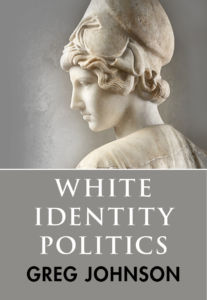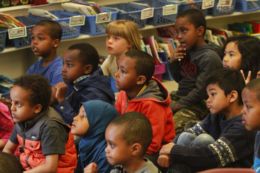The War Against White Children, Part 4
Part 4 of 4 (Part 1 here, Part 3 here)
The School Experience
While working on and thinking about this piece over the last few years, I spoke with several white middle-school and high-school students and conducted informal interviews about their experiences. The differences between the students at the diverse schools and the students at the predominantly white schools could not have been further. The student from friendly, safe, mostly white schools talked about how particular academic subjects were difficult, or how certain teachers were personally vexing. They shared stories of typical high-school life: pranks that perhaps went a bit too far, leading to hilarious situations that ultimately ended in brief suspensions; and soap opera-esque drama involving love triangles. No student from the homogeneous white schools made any mention of race. They did not seem to think about it one way or the other. What they described was more akin to one of those coming-of-age comedy films than anything else.
The stories I heard from the two students who attended diverse schools were troubling. When I asked the male about it, he brought up race issues without any prompting. He told me he has no real friends, he cannot relate to his classmates, and they naturally keep to their own groups. Somalis, Ethiopians, Mexicans, Guatemalans, and American blacks were the major ethnic groups in his school. They spoke in their native languages among themselves and were hostile to outsiders, which is ironic considering their status as alien interlopers to begin with, being the ultimate outsiders. My student friend did not mention academics much; they seemed to be merely a backdrop to trying to survive another week in a prison-like environment.
He told me that only a week before our chat, a student had been thrown over a second-floor railing during a fight that then became a gang fight. He had a dozen videos of fights from his lunch hour on his phone. This particular fight started as many of them do, namely as an extension of African tribal conflicts or the simple inability of radically different groups to coexist in proximity. Students commonly record the brawls and upload them to social media, which is also part of their culture. If there is a conflict in Somalia, for example, the same factions that are attending a school in the US carry on the conflict there. Once when border scuffles had taken place between Ethiopian and Somali fighters in Africa, Ethiopians and Somalis brawled in the cafeteria the next day at his high school.[1] “I couldn’t distinguish between being in Somalia and being in St. Paul,” a Sheriff’s office worker noted of the relationship between the population and criminal activity in Minneapolis.[2]
A police trainer in Columbus, Ohio tasked with educating officers on gang activity observed that “African gangs in the United States are nothing new. But they are becoming a more prevalent concern for law enforcement in cities that have significant African immigrant populations.”[3]
The daily horror experienced by the white female high school student I spoke to was the worst by far. Her days are filled with constant sexual harassment by her black male “peers.” She is cat-called, groped, and asked to meet with the urban youths outside of school all day. When she declines their advances, she is immediately called a racist by the black males, the women, and even her so-called friends. She has no real friends or opportunities to make new girlfriends or to meet a young white man. Left behind by white flight, stuck in a diverse high school, pretty, and blonde: few things could be more unfortunate than such a combination.

You can buy Greg Johnson’s White Identity Politics here.
Both of the students from the diverse schools noted that everything they do is perceived as “racist.” If a black or brown student asks them for money, school supplies, exam answers, a date, or sexual favors, if they decline they are immediately called “racist.”
Another interview I conducted was about the bussing programs to integrate schools in the 1970s. I spoke to a woman and her friend who had experienced it firsthand in Columbus, Ohio. One of them told me about being forced to leave the school that had been close to her home, as well as all her friends and teachers, and to ride a bus to another school on the other side of town where the majority of students were black. The other woman was allowed to remain in the same school, but had many of her friends were reassigned and replaced with busloads of blacks from the other side of town. Nothing went well for either. The girl who underwent bussing faced constant harassment and physical bullying, while the one who remained in the same school experienced new tensions as the blacks acted out in class, started fights with the boys, and made constant sexual advances on the girls.
Few schemes did more to harm white children than the 1954 Supreme Court decision of Brown v. Board of Education and the cases that followed.
Conclusion
While the likes of the San Francisco Chronicle are content to claim that “minority youth will keep America great, white anxiety will not,”[4] when looking at the test scores in reading and math among minority youth and observing their general behavior, I am not as optimistic as they are.
White children are being forced into schools where they are more likely to be attacked or bullied than they are to make friends. They are taught to hate themselves and their heritage while proselytizing about “white privilege.” If there is any upside to this, it is that millions of children and their families are seeing the standard liberal shibboleths about equality, racial harmony, and alleged racial similarities being shattered in front of them daily. Whether or not this has any effect on changing their views or behaviors remains to be seen.
The effects have already been horrendous, and are far from over. The suicide rate for white children is rising rapidly, and painkiller and antidepressant overdoses have increased in the past 20 years.[5] Diverse schools exacerbate young white suicides. The Farris study “Race Social Networks, and School Bullying” (2006) found that for every 1% increase in the non-white population at a school, the likelihood of suicide also increases by one percent (p. 93). Being bullied harshly likewise increases suicide rates, which we know from the studies happens more often to white children in diverse schools.
Young people go out less, have fewer friends, and go on fewer dates; their depression rates have never been higher. The trends and forecasts are dismal, to say the list.
I know with certainty that the world I grew up in as a child in the 1990s is gone. It was perhaps the last decade in which the majority of white children in the US were able to experience Old America. But it does not have to be this way.
These are difficult times with constant challenges. It is becoming more difficult — not to mention more expensive — by the day to avoid this plague of locusts. Keenly understanding what we and our nation’s children are facing is critical to putting an end to this state of affairs.
* * *
Like all journals of dissident ideas, Counter-Currents depends on the support of readers like you. Help us compete with the censors of the Left and the violent accelerationists of the Right with a donation today. (The easiest way to help is with an e-check donation. All you need is your checkbook.)
For other ways to donate, click here.
Notes
[1] “Over 100 Killed in clashes in Ethiopia’s Afar, Somali regions,” Al Jazeera, April 7, 2021; Laura Yuen. “Young men escape bloodshed in Somalia, but find violence in Minnesota,” MPR News, January 25, 2010; “Rise of Somali Gangs Plagues Minneapolis,” CBS News, July 20, 2009; and Adam Baidawi, “Australia’s Prime Minister Warns of ‘Gang Violence’ by African Migrants,” The New York Times, January 4, 2018.
[2] Kimiko de Freytas-Tamura, “In Minneapolis, Somali-Americans Find Unwelcome Echoes of Strife at Home,” The New York Times, June 7, 2020.
[3] Tony Avendorph,. “African Immigrant Gangs,” Police Magazine, April 4, 2012.
[4] William Frey, “Minority youth will keep America great; white anxiety will not,” San Francisco Chronicle, July 31, 2018.
[5] Dennis Campbell, “Sharp rise in young people overdosing on painkillers and antidepressants,” The Guardian. September 10, 2018.



